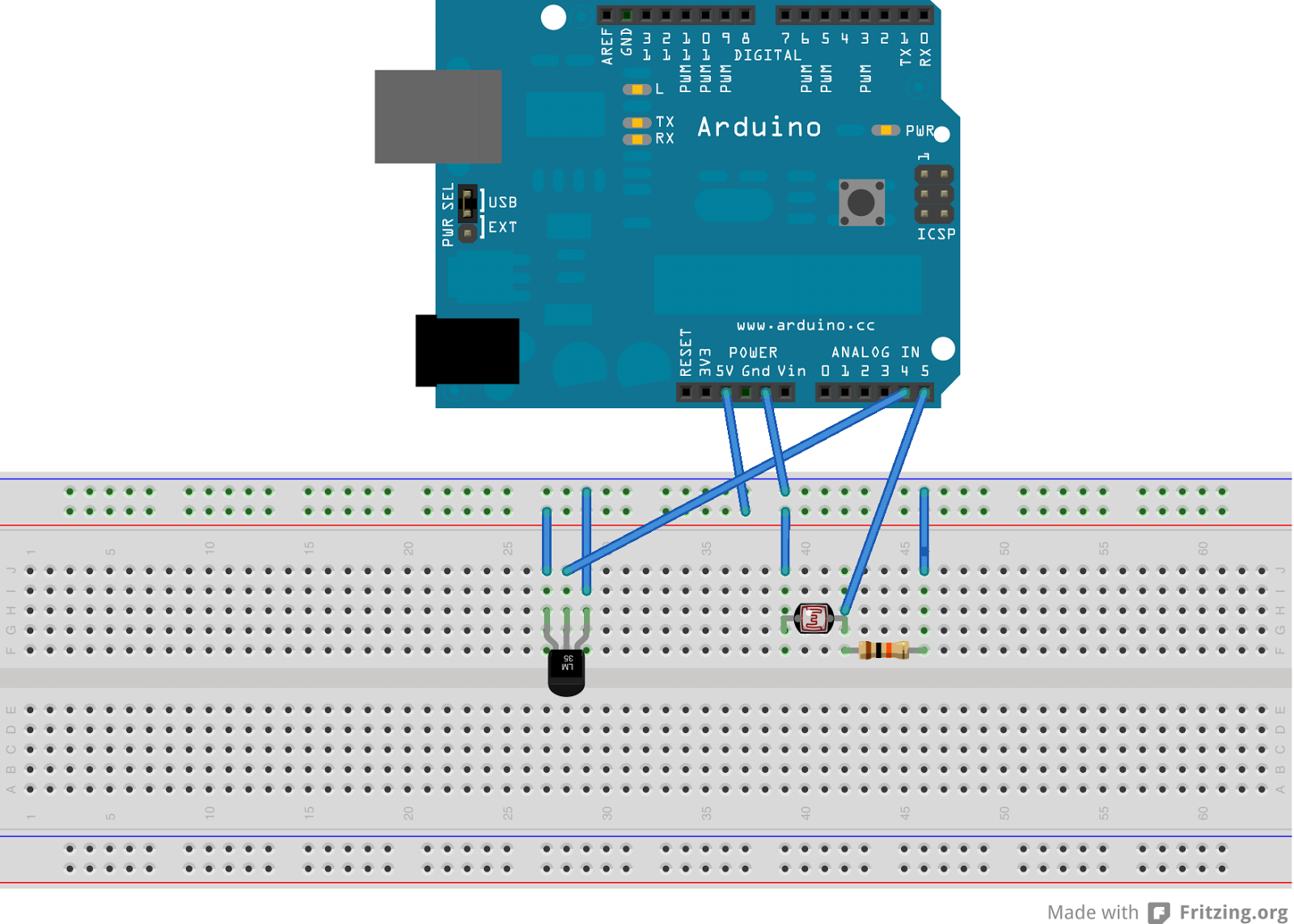
arduino temperature and light sensor

This device transmits data regarding the state of an office to Twitter, as it is deemed slightly more relevant than sharing similar information about a residence. It holds potential significance for biodiversity-related activities, especially when integrated with long-range WiFi technologies. Data gathered from a comparable device used alongside a malaise trap could provide insights into the behavior of collected specimens. The device depicted below does not include the Arduino Ethernet shield, which connects it to the internet. The actual device utilizes an Arduino prototyping shield mounted on top of the Ethernet shield for practical reasons. Temperature is measured using an LM35 temperature sensor, while light levels are assessed imprecisely with a photoresistor, which could have been calibrated but is currently employed merely to detect whether light is on or off. Although its current utility may be limited, a rugged, battery-powered, weatherproof version could offer numerous applications for biodiversity sciences, particularly when combined with additional sensors, such as a humidity sensor. Besides the Twitter-enabled version for remote data collection, the Ethernet shield also features a micro SD card reader for offline data storage, enabling later retrieval.
The device operates using an Arduino microcontroller, which serves as the core processing unit for data acquisition and transmission. The LM35 temperature sensor provides an analog output proportional to the temperature, allowing the microcontroller to read and interpret temperature data effectively. The photoresistor, while not calibrated, serves as a simple binary sensor to indicate light presence, which can be useful in various monitoring applications.
The integration of the Arduino Ethernet shield facilitates internet connectivity, enabling real-time data sharing on Twitter. This capability is particularly useful for environmental monitoring and public engagement in biodiversity initiatives. The micro SD card reader enhances the device's functionality by allowing data to be stored locally, which can be beneficial in scenarios where internet access is intermittent or unavailable.
Future iterations of this device could incorporate additional environmental sensors, such as humidity or soil moisture sensors, to expand its utility in ecological studies. A ruggedized design would ensure that the device can withstand harsh outdoor conditions, making it suitable for field research. The combination of remote data collection and offline storage provides flexibility in data management, allowing researchers to analyze trends over time and contribute valuable insights to biodiversity science.This device just sends data about the state of our office to Twitter (mainly because it`s just slightly more relevant than sending the same information about my house). It does however have potential relevance to more biodiversity themed activities, particularly if combined with long range WiFi technologies (which I have written abou
t before: Installing remote WiFi on the Jurassic Coast ). Data collected from a similar device used in conjunction with a malaise trap might start to give clues about the behaviour of the things you collect, to give one example. The device shown below omits the Arduino Ethernet shield which is used to attach the device to the internet.
The prototyping board used in the actual device is, for reasons of practicality, an Arduino prototyping shield attached on top of the Ethernet shield. The temperature is measured using an LM35 temperature sensor, and the light measured (imprecisely) using a photoresistor (which we could have calibrated but we just use to detect whether the light is on or off).
So it might not be the most useful thing at present, but a ruggedised, battery powered, weatherproof version could have a huge number of potential uses for biodiversity sciences, particularly if combined with other sensors (e. g. a humidity sensor). In addition to the tweeting version (which allows for remote data collection) the Ethernet shield also has a micro SD card reader, allowing for storage of data offline for collection at a later date.
🔗 External reference
The device operates using an Arduino microcontroller, which serves as the core processing unit for data acquisition and transmission. The LM35 temperature sensor provides an analog output proportional to the temperature, allowing the microcontroller to read and interpret temperature data effectively. The photoresistor, while not calibrated, serves as a simple binary sensor to indicate light presence, which can be useful in various monitoring applications.
The integration of the Arduino Ethernet shield facilitates internet connectivity, enabling real-time data sharing on Twitter. This capability is particularly useful for environmental monitoring and public engagement in biodiversity initiatives. The micro SD card reader enhances the device's functionality by allowing data to be stored locally, which can be beneficial in scenarios where internet access is intermittent or unavailable.
Future iterations of this device could incorporate additional environmental sensors, such as humidity or soil moisture sensors, to expand its utility in ecological studies. A ruggedized design would ensure that the device can withstand harsh outdoor conditions, making it suitable for field research. The combination of remote data collection and offline storage provides flexibility in data management, allowing researchers to analyze trends over time and contribute valuable insights to biodiversity science.This device just sends data about the state of our office to Twitter (mainly because it`s just slightly more relevant than sending the same information about my house). It does however have potential relevance to more biodiversity themed activities, particularly if combined with long range WiFi technologies (which I have written abou
t before: Installing remote WiFi on the Jurassic Coast ). Data collected from a similar device used in conjunction with a malaise trap might start to give clues about the behaviour of the things you collect, to give one example. The device shown below omits the Arduino Ethernet shield which is used to attach the device to the internet.
The prototyping board used in the actual device is, for reasons of practicality, an Arduino prototyping shield attached on top of the Ethernet shield. The temperature is measured using an LM35 temperature sensor, and the light measured (imprecisely) using a photoresistor (which we could have calibrated but we just use to detect whether the light is on or off).
So it might not be the most useful thing at present, but a ruggedised, battery powered, weatherproof version could have a huge number of potential uses for biodiversity sciences, particularly if combined with other sensors (e. g. a humidity sensor). In addition to the tweeting version (which allows for remote data collection) the Ethernet shield also has a micro SD card reader, allowing for storage of data offline for collection at a later date.
🔗 External reference





